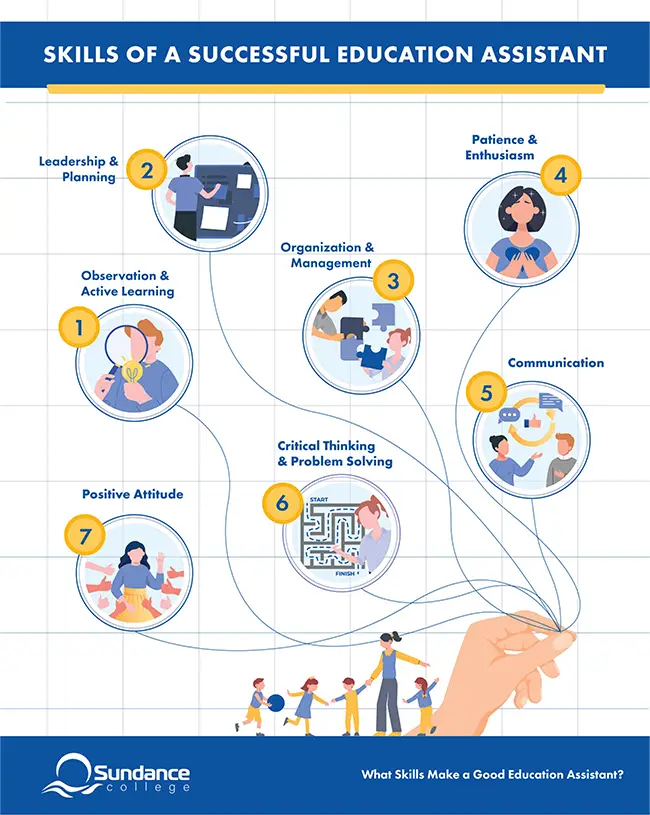Blog / What Skills Make a Good Education Assistant?
What Skills Make a Good Education Assistant?

Education Assistant Diploma
- Education Assistant
- Educational Resources Assistant
- Homework Assistant
- Remedial Education Aide
Table of Contents
Beginning a career as an education assistant (EA) means taking on a role with purpose, passion, and a huge impact on the students you support. You become a guide, mentor, and supporter, as well as an integral part of the educational team that not only sets students up academically but prepares them for independence and a place in society.
Being an EA is a rewarding position that allows you to see the growth and development of the students you support. There are many reasons to become an EA and this career requires many traits and skills that you can develop through training and experience.
If you’re looking for a career in the education field, you’ll be wondering what skills you need to succeed and build your teaching support competencies. Here are the key skills you’ll need for a fulfilling career as an education assistant.
Prefer to listen? We’ve adapted our blog into audio format so you can listen on the go.
Listen to: “Essential Skills of an Education Assistant”
Observation and Active Learning Skills
Observation skills are essential for anyone in the education field. No two students are alike as each come with their own set of unique behaviours, learning styles, and needs. This is where observation and active learning come into play.
Observation in the educational field involves keenly observing students and understanding how they interact with their environment. By watching and listening, EAs can help teachers identify and understand the learning styles of students based on their natural behaviors. This allows teachers to tailor lesson plans to meet the individual needs of each student, ensuring no one is left behind. It also assists EAs or classroom assistants when building rapport with students as they thoroughly understand their personalities, attitudes, and values.
Active learning goes beyond traditional teaching methods. It’s a learning support strategy that focuses on engaging students in the learning process through activities, discussions, and reflective practice rather than having them passively listen to long lectures.
By using active learning and keen observation skills, education assistants help to foster a dynamic and inclusive classroom environment that ensures each student receives the support they need.
Leadership and Planning Skills

EAs often work with teachers when creating and implementing educational plans, such as lesson plans and classroom layouts. A good understanding of classroom planning techniques is invaluable as an education assistant as it allows them to contribute towards the learning goals and agenda of the teacher and support student success.
When it comes to implementing these plans, there are times when an educational assistant may be called upon to lead student activities like transitions, ‘circle time’ for younger students, and one-on-one activities. Education assistants must establish themselves as an authority figure in the classroom, drawing on their knowledge and experience to carry out leadership tactics and strategies.
Organization and Management Skills
Education assistants are not only responsible for keeping themselves organized, like most other professionals. They must support the teacher, other members of the educational team, and the students too.
Classroom Organization
The classroom should be kept organized for an effective learning environment. This involves ensuring the classroom is clutter-free to allow teachers and students to access the tools and equipment they need.
Education assistants are not the only ones who need to be keeping the classroom clean and tidy – students, under the guidance of EAs and other teaching aides, should be learning how to respect their environment by putting things away and maintaining a tidy workspace. This means education assistants manage organization skills of their students, too.
Classroom Management
Education assistants are there to support teachers in managing the learning environment, classroom team, and the students. This could include using positive reinforcement techniques with students to set behaviour expectations, providing feedback to the teacher based on observations, and assisting with transitions in the classroom and other environments.
It could also mean teaching assistants using their own classroom management techniques and student engagement strategies by leading group discussions or spending one-on-one time with individual students while the teacher manages the rest of the class.
Ultimately, it comes down to being part of a classroom team who can work together to stay organized and achieve their objectives.
Time Management
When it comes to time management, education assistants need to be able to manage their own time, as well as that of their students.
EAs are often tasked with managing the duration of activities. This involves keeping track of time and aligning each activity with the teacher’s agenda. Balancing priorities as an assistant is key as you must balance the needs of individual students, the expectations of the teacher, and unforeseen challenges that may arise.
Patience and Enthusiasm for Working with Children
The role of an education assistant revolves around the needs of students of all ages ranging from nursery-aged toddlers to adult learners. EAs understand that every student is different and comes with their own set of challenges and rewards. Patience is a necessary skill for education assistants, especially when working with young children who are still in their formative years.
In the classroom, young learners can easily lose focus or exhibit disruptive behavior. They might even throw the occasional temper tantrum. An EA or teaching assistant should have the ability to see beyond these moments and identify opportunities for growth and development. That’s where the enthusiasm for supporting children comes in.
The enthusiasm teaching assistants have for guiding the student development is what often helps them navigate through situations with grace and ease, ensuring that every child feels supported and encouraged as they grow.
It’s also important to remember that not all learning is academic. Alongside math and reading, young children are learning how to socialize, communicate, and fit into the world around them. The role of an education assistant or teaching aide is to support teachers in helping their students develop the key social and life skills that they will need to become successful adults. Through patience and enthusiasm, EAs act as mentors, guides, and supporters for their students to ensure they reach their full potential.
Communication and Interpersonal Skills

Effective communication skills in education don’t only come from being able to communicate through various methods. When it comes to teaching assistants, they need to be able to communicate effectively with a variety of individuals in various settings including their co-workers, students, parents, and the rest of the educational team. While having a ‘circle time’ puppet show may work for your students, it’s probably not the best way to communicate with your employer, for example.
Education assistants also need to expand their communication and interpersonal skills beyond simply getting their point across. They need to be able to listen to those around them to enhance their classroom support abilities and help the teachers and students in the best way possible.
Social Perceptiveness
Education assistants need to be able to draw on their social perceptiveness and child development principles to help in their communication. This involves being aware of the reactions of others, identifying why they are acting that way, and implementing the best form of communication with them. This can come in handy when dealing with temper tantrums, disgruntled parents, or a stressed-out teacher.
Teamwork
As an education assistant, you are there to support the teacher in any way possible, which means you need to understand their intentions and classroom needs by practicing effective communication and working as a team. You need to be available to listen to their instruction as team leader, carry it out effectively, and provide feedback at the appropriate time.
The use of teamwork in classrooms and other learning institutions helps the teachers and classroom assistants achieve their goals while creating a supportive learning environment for students.
Critical Thinking and Problem-Solving Skills
A big part of the role of an education assistant is solving unexpected problems that arise. Whether it’s a lack of materials, an accident in class, behavioural problems, or learning issues, critical thinking skills are required to come up with quick, and often creative, solutions.
By refining your critical thinking and problem-solving skills, you can navigate classroom challenges with confidence, demonstrate creativity in teaching assistance, and provide the support needed by the teacher while ensuring that every student can learn and grow.
Flexibility and Adaptability
Flexibility and adaptability go hand-in-hand with critical thinking skills. As unexpected issues arise, education assistants need to be able to pivot and quickly step up to the challenge. But these aren’t the only times when EAs need to be adaptable.
EAs need to be able to adapt to a range of teaching assistant responsibilities and situations. From stepping in to lead students in different subjects and unusual settings, to supporting students with varying capabilities, to collaborating with a range of teachers who each have their own preferences, you must be able to switch gears at a moment’s notice.
In order to be flexible and adaptable, education assistants need to have a deep understanding of teaching methods, as well as the flexibility to adjust their approach based on the needs of the students and the requirements of the lesson.
Working in different learning institutions with varying principles and procedures also adds a layer of complexity. EAs must be able to quickly familiarize themselves with new environments and adapt their teaching and classroom support style to fit the culture and practices of each institution.
By embracing change and approaching each new challenge and environment with an open mind, you can create a dynamic and engaging learning environment where the teachers and students are able to succeed.
Positive Attitude
One final vital skill that all education assistants need is a positive attitude. This doesn’t just mean simply smiling and being cheerful; it’s about creating a supportive and encouraging atmosphere where every student feels valued and motivated to learn.
Young children you may work with are especially perceptive to a positive attitude as they often mirror the adults around them. Between their home life and school, an education assistant becomes a major influence in the lives and development of the children they support. A positive, calm, and resilient attitude from a teacher or EA can be contagious and a key factor in students’ approach to learning, conflict resolution, and emotional intelligence.
A positive attitude is also key to succeeding in your role as an education assistant. It allows you to approach challenges with a can-do attitude, find creative solutions to problems and maintain a sense of optimism even in difficult situations. This not only contributes towards the academic growth of your students, but it also aids your own skill advancement and professional development.

How to Develop Essential Education Assistant Skills
After learning about essential teaching assistant skills, the next step is to assess the skills you already have and identify which ones you need to develop. Don’t worry if you don’t ‘check all the boxes’ right now. The right training and practical experience will provide the skills you need to succeed in the education field.
Sundance College has an Education Assistant diploma program that not only gives you the education support skills and knowledge you need in this industry, but also provides hands-on experience. Our curriculum offers classes like Observation Skills and Applied Behaviour Analysis, as well as many others, to equip you with the necessary knowledge for this career. The program is streamlined, lasting 43 weeks with an included 10-week practicum period to translate theory into practice.
Ready to learn more about this career? Check out our career overview guide to find out how you can become an education assistant and reach out to one of our academic advisors to get started on your journey to this career.
Related Blogs
Subscribe for more career advice
Blog Categories
Share on:
